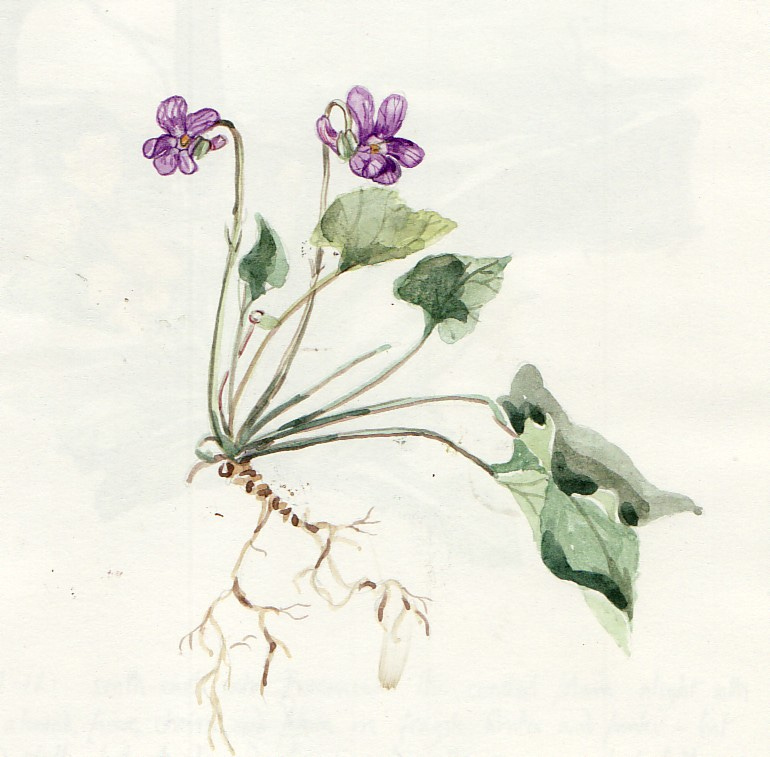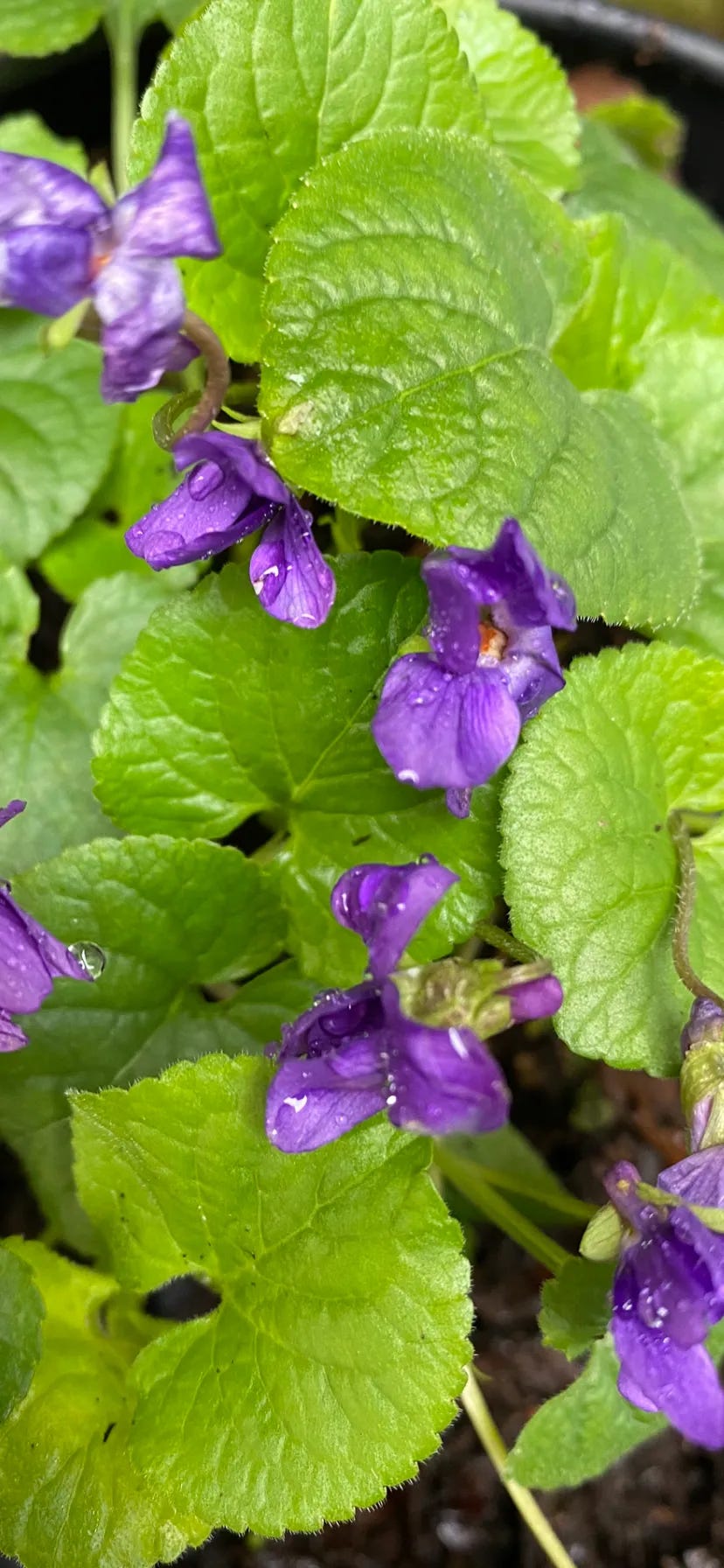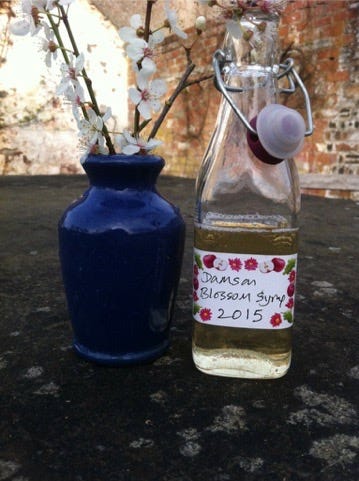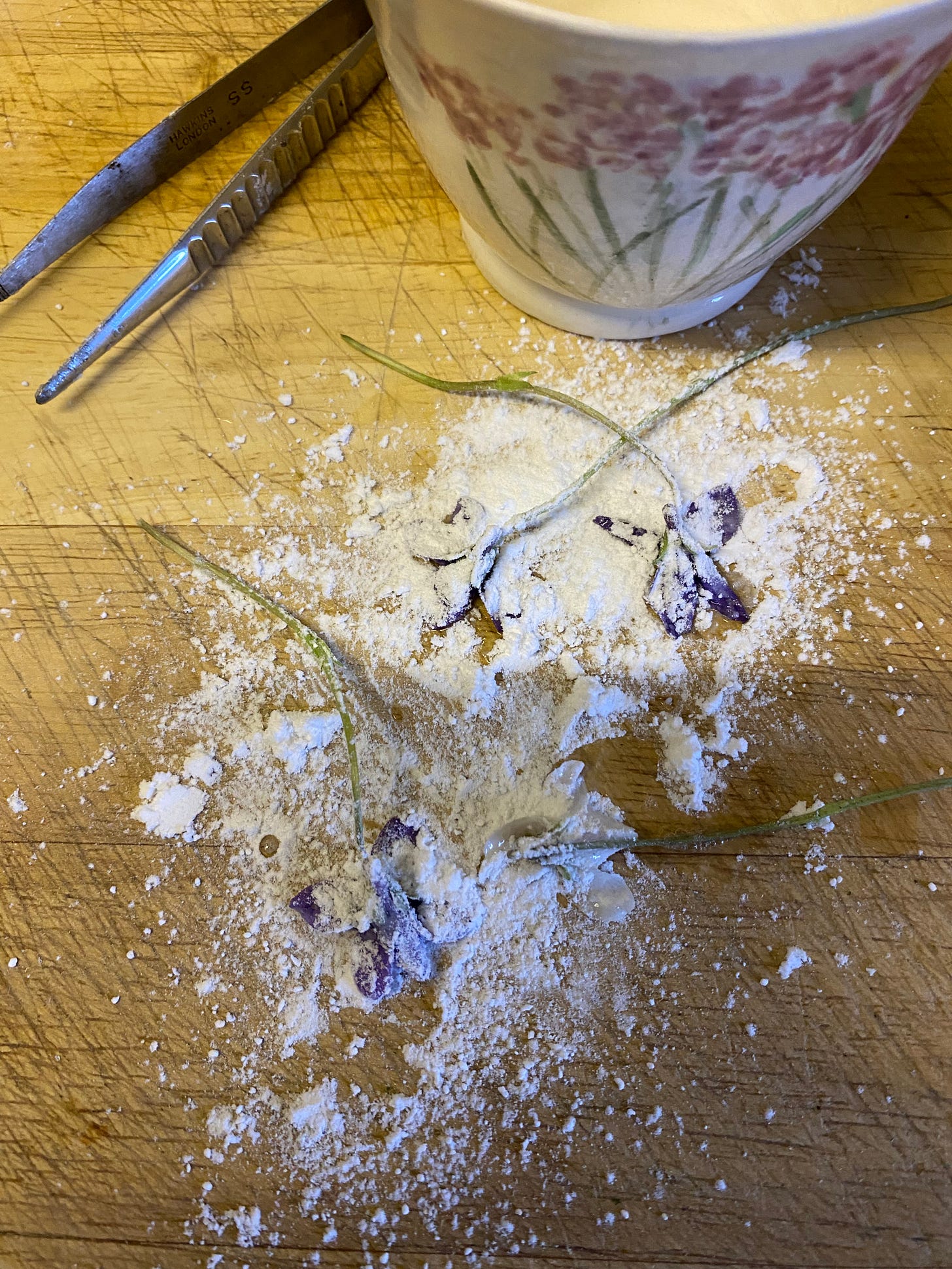
WELCOME, maids of honour.
You do bring in the Spring and wait upon her.
(Robert Hedrick)
This month woods are carpeted with violets. The fragile flower that takes its name from its intense purple colour may also be yellow, blue or white and there are said to be over five hundred species belonging to the genus Viola. This delicate, tiny flower with heart shaped leaves is synonymous with early spring. In the Western isles, I pick Heath Violets; in common with Dog Violets these violets lack scent, but both will produce culinary magic in the kitchen. A child friendly foraging activity in March could involve picking wild violets and then participating in a Chemistry Practical Lesson whilst making violet tea.
Gather a small basket of wild violet flowers. As always, harvest on a dry day in an area free from pesticides and dog walkers. Put the violets in a colander, rinse briefly and then pop them into a bowl. Cover the flowers with boiling water and steep for 30 minutes until the liquid colours. Strain the violets and the resulting liquid will be blue. The greater the concentration of flowers, the stronger the colour. Add honey to taste and enjoy a cup of Wild Violet Tea. Violets contain natural, water soluble pigments - anthocyanins which are responsible for their vibrant colour. To continue the Chemistry experiment add lemon juice or vinegar (acid) to the unsweetened violet liquid - it will turn pink. Whilst writing the Forager’s Kitchen Handbook we added violets to gin (it turns purple) and discovered that when tonic water is added, it changes colour again. All very exciting. The violet amongst other flowers, is a natural indicator of pH - showing high or low levels of acid depending on the colour change. If you add violets to gin or indeed any alcohol, it is important to remove anything green, sepals as well as stalks. Petals alone ensure purple alcohol.
Violets are linked to Aphrodite and were exchanged on wedding days. Less romantic in Greek mythology is the vision of Persephone collecting violets when she was kidnapped by Hades with the hope that she would become his Queen Consort in the Underworld. The Romans in common with the Greeks had a fondness of violets. They associated the tiny flower with remembrance and mourning but also infused violets in celebratory wine.
Look carefully at the violet in situ. It lowers its head in deferential style, hiding under heart shaped leaves - hence the flower’s association with modesty - possibly generating the expression ‘to be a shrinking violet’. A retiring soul.
Sweet Violets are delicate and scented. At one time the flowers were cultivated on a large scale in England, Italy and France. In the Victorian era, this fashionable flower was harvested and sent by train to London. In the city the violets were used in funeral and wedding bouquets and posies were sold by flower sellers at railway stations and on street corners. I love this idea, but suspect if I requested violets in a florist shop today, they may look at me somewhat quizzically. Such was the huge demand for violets that violet nurseries were established in Kent, Sussex and Devon. In spring, large fields of the South East and West country were purple and scented. Divine.
Mothering Sunday saw servants return to their Mother Church (where they were baptised) to gift their own mothers a bunch of violets or primroses. Celebrated on the fourth Sunday in Lent, Mothering Sunday (Refreshment, Laetare or Rose Sunday), also permitted a lapse in fasting, often to consume Simnel Cake decorated with crystallised primroses and violets.
In the final decades of the reign of Queen Victoria and the years of Edward VII, the gardens of Windsor Castle were under the supervision of John Dunn. At this time circa 3000 violets were grown in protected frames. Violets are so very Victorian. It is an interesting concept that a flower that symbolises humility and modesty was associated with aristocracy and the ruling classes. Queen Victoria herself is reported to have had a lifelong love of violets; first referencing them in her childhood diary. By the time that Virginia Woolf was penning words, the traditional association of violets with marriage and courtship was waning. There may be a description of Mrs Dalloway smelling of violets, yet In Night and Day, Mrs Hilbery tells us that she remembers violets in the parlour ‘before things were hopeless’.
‘Even if fall she must, it was to lie on the earth and moulder sweetly into the roots of violets.’ Virginia Woolf
Napoleon (or one of his soldiers) is credited for bringing the Parma Violet from Italy to Toulouse in France, as a gift for a lady. It is well documented that Napoleon’s wife, Josephine de Beauharnais (1763-1814) carried violets on her wedding day and was given violets on anniversaries, hinting that there is possible truth in the Toulouse story. Napoleon adopted the violet as his political emblem. Indeed, when banished to Elba, Napoleon said that he would return with the violets (in spring). When he escaped to Paris on March 20th 1815, he was presented with violets and called Le Pere La Violette. I’m told that the mauve Parma Violet is one of the most difficult to grow. It was however, a species that Napoleon’s wife, Josephine, cultivated with success in the gardens of the Chateaux de Malmaison on the outskirts of Paris. Toulouse is known as the City of Violets, although the flowers are also cultivated on the Cote d’Azur. The whole of the violet is used in the perfume industries in Grasse, in the hills above the French Riviera. Closeby in the medieval town of Tourettes sur Loup, an annual violet has been held since 1952. Similarly in Toulouse there is a Fete de la Violette where one can enjoy: perfume, liqueur, body oils, lotions, soaps, candles, teas, cakes and of course crystallised violets. There is a collectable Toulouse Violet Seller Doll and the Toulouse football team don violet shirts. Violet rules. In the pre second world war, violet heyday, the environs of the Romanesque Church St. Sernin was purple with heavily laden baskets of violets. These days are long past. Candying violets is hard work. Harvesting is back breaking and as a direct consequence there are fewer violet growers. Rumour is that the ability to candy violets is a dying art. Devon violet scent may still be dabbed on linen hankerchieves by older ladies, but it needs a revival. Likewise being creative with violets in the kitchen. I’m happy to take a lead.
The Parma violet is a classic sweet on the confectionary counter. A sweetie that a child with a small amount of pocket money can afford. At the high end of the market are my favourite dark chocolate violet fondants gilded with a crystallized violet. Other brands are available.
From colourful vinegar and gin, confectionery and baking, violets add originality and fragrance to recipes. The violet recipes in the Forager’s Kitchen Handbook were tested using violets gathered from the Kirk graveyard.I am far from a shrinking violet - this act of acquisition took place in full view of the Minister. In the kitchen, I added my harvested violets to an eclectic array of recipes from Pickled Quail Eggs to Violet Macarons. In the testing process my recipe testers and I discovered the indicator properties of violets. There is a step by step guide to making floral syrups in my book. It can be tricky, but the resulting fragrant violet syrup is worth the effort. When drizzled over vanilla ice cream the colour contrast is magnificent. If sugar is added in a 2:1 ratio with water (this is known as a rich syrup), there is a high chance that the blossom syrup will crystalize unless great care is taken. I don’t worry hugely because if crystallized syrup is reheated in a microwave on its defrost setting, crystals dissolve. This post is all about Violets but if I had to name a syrup blossom for lovers of marzipan, I’d mention damson blossom - almonds in a bottle.
The pretty, heart shaped violet leaves can be used in the kitchen too. They have a thickening property - useful when added to casseroles. Add raw violet leaves to spring salads and the stem is delicious too. A violet vinaigrette is a natural spring salad partnership.
French patisserie has always held violets in high regard, incorporating the crystallised flower ornately, in dainty delicacies. Indeed, the idea of using flowers in herbal medicine and in cooking is centuries old. One of my favourite uses of a crystallised violet is to pop it on on virgin white glace icing - the stark white of the icing contrasts with the royal mourning purple of the violet. Stunning and delicious too.
Foraging violets is a child friendly activity. Small hands work well. A good breath of fresh air and then into the kitchen for a chemistry or baking lesson. Any wild flower must be picked with care, sustainably, and it’s a definite ‘no’ to protected species. However, a small basket of violets to use in your own kitchen, is in my book, permissible. Let’s bring on a resurgence of violet culinary ideas. A current worry is that attention spans have shortened, but the knowledgeable forager is aware that the violet season is worthy of concentration. Screen downtime. The violet season is short, it awaits no man.
RECIPE IDEAS
Violet Sugar is a wonderful larder standby and marries well with lemons in cakes, puddings and meringues.
Layer violets with caster sugar in a jar. Seal and store in a dry place. The longer the violets are left to infuse with the sugar, the stronger the floral flavour. Store in a dark dry place for a week and then grind the sugar in a pestle and mortar or a food processor. Store the violet sugar in an airtight container and sprinkle a hint of spring violets, as you sweeten your recipes.
Crystallizing Violets. This process mummifies the tiny flower. Some crystallizrd violets are guaranteed to be nearer to perfection than others.
First pick your violets.
Leave the violets on the stem. This makes it easier to pick them up as you coat each small flower in beaten egg white and then sugar. Tweezers are useful too.
Use a paintbrush or small pastry brush to paint the flowers (top and bottom) with lightly beaten egg white.
Coat with sifted icing sugar or for a crunch, castor sugar.
Lay the sugar coated flowers on baking parchment paper and leave to dry in a warm, dry place.
Handle with care when removing the stems and store the crystallized violets in an airtight container. Use within a couple of months.










Lovely post, Fiona! Wonderfully nostalgic...violets will be everywhere under the beech hedge in my sometime garden in Wales. Used to crystalise the flowers with my grandchildrren every year. Primroses, too (primrose leaves make delicious fritters dipped in a light batter, as I'm sure you know - never tried it with violet leaves).
Sure I have a violet pic - but can't add it here as comment box won't let me. Will send it direct!